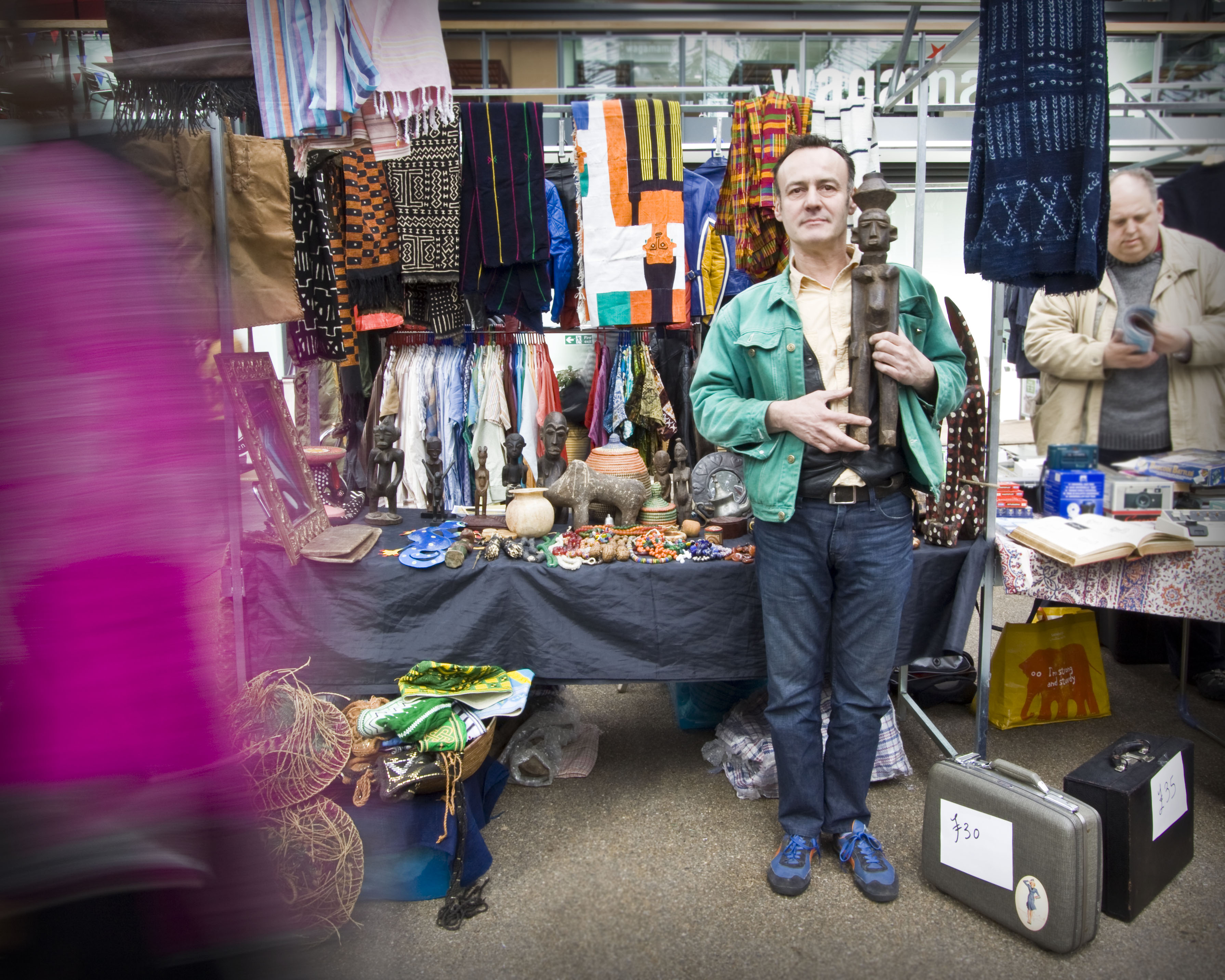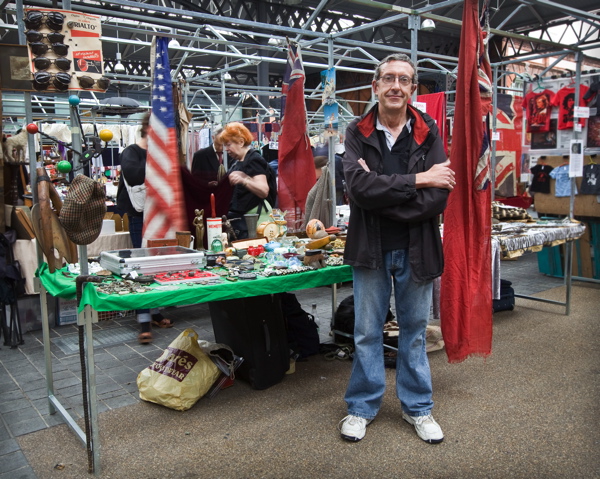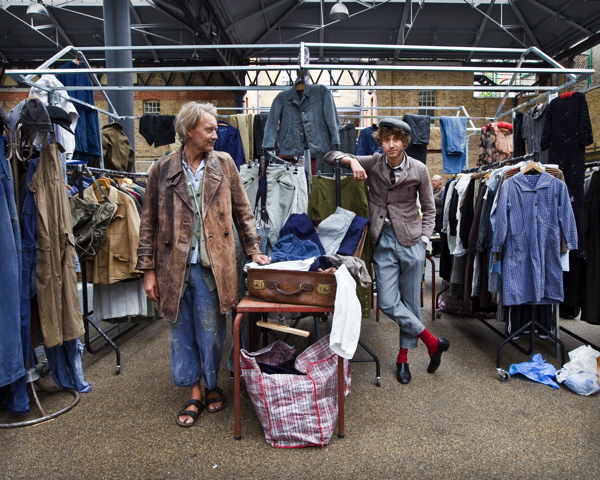Spitalfields Market Portraits
Throughout last year, I published a weekly series of more than eighty profiles, telling the stories of the traders in the Spitalfields Antiques Market accompanied with vibrant images by Spitalfields Life contributing photographer Jeremy Freedman, and the result is a distinguished body of portraiture, recording the diverse personalities who come together to create London’s pre-eminent weekly antiques market.
Fifty of these photographs will be shown three venues in Spitalfields from 10th February until 10th March, The Golden Heart in Commercial St, Agnes B in the Spitalfields Market and Rough Trade East in the Truman Brewery – as the first Spitalfields Life exhibition – produced with the gracious support of Nido, Spitalfields who have paid the costs of creating the show as a gesture of goodwill to the local community.
Jeremy Freedman’s ancestors came to Spitalfields from Holland in the eighteenth century, his great-great-great-great grandfather was one of the founders of Sandys Row Synagogue in 1854, and I am proud to present his debut exhibition as a celebration of Spitalfields today. Please come to join Sandra Esqulant and me for a drink to launch the exhibition on Thursday 10th February from 5pm at The Golden Heart. Meanwhile, I am taking this opportunity to look back at a few favourites from the series.

This is the celebrated George Cossington, an ex-steeplejack, now putting his feet up at ground level after thirty years above the roof tops.“I fell once but a corrugated iron roof saved my fall, that was in Beckton Gas Works,” he recalled in relief, grateful to be here today. “I’ve always loved old tools, but I thought,’If you sell ‘em, who’s going to buy ‘em?’ So I bought a polishing machine and I bring them back to life.”George told me, accounting for his gleaming stock of antique iron and brassware – including an especially covetable military issue pruning saw dated 1945, still in perfect condition. Just one of the myriad delights of utilitarian metalwork to be discovered at George’s stall. (Read the full story of George Cossington, Steeeplejack)

This is the gracious Sonoe Sugawara, seen here proudly holding an exquisite nineteenth century girl’s silk undergarment. Sonoe originally sold vintage English clothes from a stall in a Tokyo department store and now has a clever business going whereby she sells kimonos in London too, moving back and forth two or three times a year with a full suitcase in both directions. “My boyfriend’s great-grandparents were dealers before the war, collecting nineteenth and early twentieth century kimonos,” revealed Sonoe with a significant nod, accounting for the origins of her ravishingly beautiful stock of fine antique kimonos.

This is Sarah & Roy, a devoted couple from Dagenham. “I make the money while he’s the hard working one who carries the heavy boxes around,” admitted Sarah mischievously, slipping a protective arm around Roy. On the right hand side of the stall are Sarah’s vintage jewellery and clothes, while on the left are Roy’s childhood plastic toy soldiers, Action Men and Ladybird books. “I do feel sad parting with some because I remember playing with them,” Roy confessed to me with a sentimental smile – inspiring Sarah to wrap her arms around him and plant an emotional kiss, declaring,“Bless him, he loves it!”

This is Harvey Derriell, a lean and soulful Frenchman of discriminating tastes, and a connoisseur of tribal art from West Africa, with his prized collection of sculptures, textiles and beads, including my own personal favourite, chevron trading beads. “Fourteen years ago, I went to Mali, and I fell in love with the place and the people and I wanted to return. Now I go back four times a year.” revealed Harvey, brimming with delight. I was dismayed to learn that the Golonina bead market is closed but Harvey reassured me that beads are still to be found. “In Bamako, they ask ‘What do you want? Drugs, gold, diamonds, girls, boys or beads?’ “ he explained.

This is Linda Lewis who has been a dealer in kitchenalia, vintage china and glass for twenty years. With enviable stamina, she gets up at four thirty to drive here in all seasons from her home in North Essex. “My partner is a banker, so this is just part-time,” Linda whispered discreetly, adding “but now he’s been made redundant, maybe I’ll have to go back to doing it full-time.” Yet, demonstrating her appealingly buoyant nature, Linda qualified this by saying, “I love it, I wouldn’t do it otherwise, and because I like it so much, it doesn’t seem like work.”

This is my pal Bill, a dignified market stalwart who deals in coins, whistles, gramophone needles, souvenir thimbles, magic lantern slides, trading tokens, small classical antiquities and prehistoric artifacts. “I sell quite a few things, but on a low margin because it’s more interesting to have a quick turnover.” he admitted to me, speaking frankly, “I’m here more for enjoyment really – quite a few friends I’ve made over the years. I was a shy person before, but it’s made me confident having a stall. I’ve become an optimistic person.” Bill comes to Spitalfields each week with all his stock in a backpack and large suitcase – practical, economic and an incentive to sell as much as possible.

This charismatic chatty young Italian is Giovanni Grosso, who sells immaculately fine gloves, hand-made in the nineteen fifties by his father Alberto, the renowned glovemaker of Naples – a rare opportunity, since Alberto ceased glovemaking in the nineteen seventies. Giovanni himself is a talented sculptor who showed me some tiny cameos he has carved with astonishing skill into seashells. Currently serving an apprenticeship in stone carving with Raniero Sambuci, Giovanni explained to me that he came to London because “…in Naples, unless you compromise with the mafioso you leave!”

This is Lottie Muir & Amanda Bluglass who met through Soulmates seeking romance and discovered instead a shared passion for “Thames treasures and coastal coterie”. “I am a mudlarker and a letterpress fanatic,” explained Lottie, “so I collect Roman glass and Medieval pottery, which wash up against my flat in Rotherhithe, and arrange my discoveries in type cases.” Lottie’s finds are complimented by things selected by Amanda who is a sculptor, “All are chosen for shape or some kind of sculptural beauty,” she added with calm authority, in contrast to Lottie’s giddy excitement on this first day of their new venture.

This is the distinguished Mr Singh, expertly modelling a dress sword which belonged to the Lieutenant General to the Tower of London between 1880-90, a very fine example of its kind, that was once presented to Lord Chelmsford. “I must differentiate myself from the general public and I do it by an emphasis on quality,” explained Mr Singh modestly and, as I cast my eyes upon his impressive selection of antique silver cutlery, I found no reason to disagree. If you see Mr Singh, impeccably dressed English gentleman, and dealer in militaria and classy bric-a-brac, either here in Spitalfields or at St James, Piccadilly, be sure to pay your respects and wish him “Good day”.

This is Richard Rags and his appealingly voluble son Cosmo Wise, both dressed head to toe in the clothing from the nineteen forties and earlier that is their shared passion. They cherish the extravagantly worn-out old togs your grandparents discarded, full of vibrant character and handmade details no modern garment can ever match. Cosmo really knows how to wear it and, with admirable enterprise, is now copying his most treasured finds in old fabric, to create exclusive pieces sold under his own label “De Rien.” “We are drowning in clothes, clothes dripping from the ceiling, even beds made of clothes.” he revealed with barely concealed delight, divulging the singular living conditions at their clothing warehouse in Hackney Wick. (Read the full story of Richard & Cosmo wise, Rag Dealers.)

This is Molly & Ellen, who can be seen working together in the market every Monday, Thursday and Friday. Molly’s family have been swagmen in the East End for generations and Ellen played here in the fruit & vegetable market when she was child. “I was born in Whitechapel and this used to be our playground – only the porters could control us because they were the only ones we would listen to.” confided Ellen with a proud smirk. Molly & Ellen are two women of great spirit who speak for a resilient local community that has lived through all the changes. (Read the full story of Molly the Swagman.)

This noble man with the face of saint from a Romanesque cathedral is John Andrews, who deals in “vintage fishing tackle for the soul” and is the author of “For All Those Left Behind,” a memoir about his father and fishing. Learning that angling is a dying art, I was hooked by the melancholy poetry of John’s collection which speaks of the magnificent age of British fishing between the mid-nineteenth and mid-twentieth century. “I am addicted to buying and selling it, and I live in my own little world,” confessed John, which sounded so appealing to me that I accepted his invitation to join a fishing trip immediately. Corduroys by Old Town.
Photographs copyright © Jeremy Freedman


















